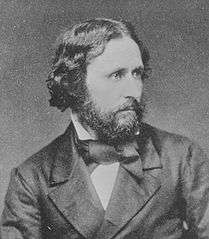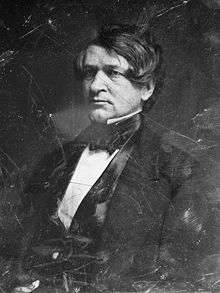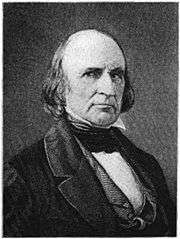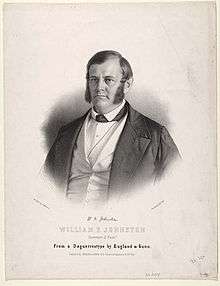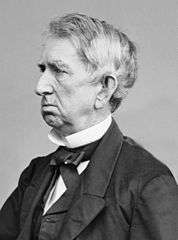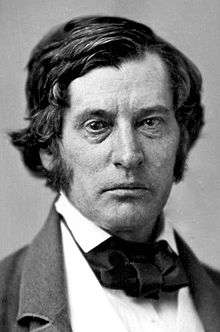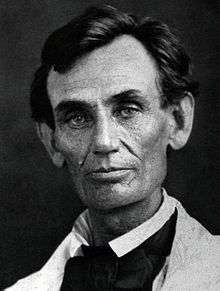1856 Republican National Convention
|
1856 presidential election | |
|
Nominees Frémont and Dayton | |
| Convention | |
|---|---|
| Date(s) | June 17–19, 1856 |
| City | Philadelphia, Pennsylvania |
| Venue | Musical Fund Hall |
| Candidates | |
| Presidential nominee |
John C. Frémont of California |
| Vice Presidential nominee |
William L. Dayton of New Jersey |
The 1856 Republican National Convention, also known as the first Republican National Convention, met from June 17 to June 19, 1856, at the Musical Fund Hall in Philadelphia, Pennsylvania, USA. The gathering nominated Major General and former Senator John C. Frémont of California and former Senator William Dayton of New Jersey for President and Vice President, respectively, as the fledgling party's standard-bearers the 1856 presidential election. The convention also appointed a Republican National Committee to govern the new organization.
The June 1856 Nominating Convention was preceded by an informal organizational convention held February 22–23, 1856 which elected a National Committee who set the dates of the convention and the terms for delegate participation.
History
Background
On June 19, 1855, a small gathering of like-minded individuals met in Washington, D.C. where they passed a resolution noting the recent abrogation of "all compromises, real or imaginary" by the opening up of the state of Missouri and the territories of Kansas and Nebraska to the possible institution of slavery.[1] These proclaimed themselves the "Republican Association of Washington, District of Columbia" and passed a simple four plank platform including the demand that "There should be neither slavery nor involuntary servitude, except for the punishment of crime, in any of the Territories of the United States."[2] A number of state organizations were soon established along similar lines and the Republican Party was effectively born.
On January 17, 1856, representatives of Republican Party organizations in Ohio, Massachusetts, Pennsylvania, Vermont, and Wisconsin — all Northern states in which slavery was prohibited — issued a joint call for an "informal Convention" to be held in Pittsburgh, Pennsylvania, on February 22, 1856, in order to perfect the national organization and to call a formal, properly delegated national convention to nominate candidates for President and Vice-President of the United States for the forthcoming November 1856 election.[2] The gathering elected a governing National Executive Committee and passed various resolutions calling for the repeal of laws enabling slaveholding in free territories and "resistance by Constitutional means of Slavery in any Territory," defense of anti-slavery individuals in Kansas who were coming under physical attack, and a call to "resist and overthrow the present National Administration" of Franklin Pierce, "as it is identified with the progress of the Slave power to national supremacy."[3]
The 22-member Republican National Committee, which included one representative per state attending the Pittsburgh Convention, met in plenary session on March 27, 1856, at the Willard Hotel in Washington, DC and issued a call for a formal presidential nominating convention.[4] This was slated to begin on June 17, 1856, in Philadelphia.[4] Each state organization was to be allocated six at-large delegates, plus three delegates for each congressional district.[4]
North American Party convention
The candidates to be nominated by the New Republican party were first nominated by the Antislavery rump of the American party.
-

Speaker
Nathaniel P. Banks
of Massachusetts
(Declined Nomination)
The anti-slavery "Americans" from the North formed their own party after the nomination of Fillmore in Philadelphia. This party called for its national convention to be held in New York, New York, just before the Republican National Convention. Party leaders hoped to nominate a joint ticket with the Republicans to defeat Buchanan. The national convention was held on June 12 to 20, 1856 in New York. As John C. Frémont was the favorite to attain the Republican nomination there was a considerable desire for the North American party to nominate him, but it was feared that in doing so they may possibly injure his chances to actually become the Republican nominee. The delegates voted repeatedly on a nominee for president without a result. Nathaniel P. Banks was nominated for president on the 10th ballot over John C. Frémont and John McLean, with the understanding that he would withdraw from the race and endorse John C. Frémont once he had won the Republican nomination. The delegates, preparing to return home, unanimously nominated Frémont on the 11th ballot shortly after his nomination by the Republican Party in Philadelphia. The chairman of the convention, William F. Johnston, had been nominated to run for vice-president, but later withdrew when the North Americans and the Republicans failed to find an acceptable accommodation between him and the Republican nominee, William Dayton.[5]
| Presidential Ballots | 1 | 2 | 3 | 4 | 5 | 6 | 7 | 8 | 9 | 10 | 11 | Vice Presidential Ballot | |
|---|---|---|---|---|---|---|---|---|---|---|---|---|---|
| Nathaniel P. Banks | 43 | 48 | 46 | 47 | 46 | 45 | 51 | 50 | 50 | 53 | 0 | William F. Johnston | 59 |
| John C. Fremont | 34 | 36 | 37 | 37 | 31 | 29 | 29 | 27 | 28 | 18 | 92 | Thomas Ford | 16 |
| John McLean | 19 | 10 | 2 | 29 | 33 | 40 | 41 | 40 | 30 | 24 | 0 | John C. Fremont | 12 |
| Robert F. Stockton | 14 | 20 | 18 | 0 | 0 | 0 | 0 | 0 | 0 | 0 | 0 | Scattering | 21 |
| William F. Johnston | 6 | 1 | 15 | 0 | 0 | 0 | 0 | 0 | 0 | 0 | 0 | ||
| Scattering | 5 | 0 | 0 | 0 | 1 | 2 | 0 | 0 | 0 | 0 | 0 |
The First Republican Convention
The first Republican National Convention was held in the Musical Fund Hall in Philadelphia, Pennsylvania, on June 17 to 19, 1856. The convention approved an anti-slavery platform that called for congressional sovereignty in the territories, an end to polygamy in Mormon settlements, and federal assistance for a transcontinental railroad. John C. Frémont, John McLean, William Seward, Salmon Chase, and Charles Sumner all were considered by those at the convention, but the latter three requested that their names be withdrawn. McLean's name was initially withdrawn by his manager Rufus Spalding, but the withdrawal was rescinded at the strong behest of the Pennsylvania delegation led by Thaddeus Stevens.[6] Frémont was nominated for president overwhelmingly on the formal ballot, and William L. Dayton was nominated for vice-president over Abraham Lincoln.
Candidate gallery
Convention Balloting
| Presidential Ballots | Informal 1 | Formal 1 | Vice Presidential Ballots | Informal 1 | Formal 1 |
|---|---|---|---|---|---|
| John C. Fremont | 359 | 520 | William L. Dayton | 253 | 523 |
| John McLean | 190 | 37 | Abraham Lincoln | 110 | 20 |
| Charles Sumner | 2 | 0 | Nathaniel P. Banks | 46 | 6 |
| Nathaniel P. Banks | 1 | 0 | David Wilmot | 43 | 0 |
| William H. Seward | 1 | 1 | Charles Sumner | 35 | 3 |
| Abstaining | 14 | 9 | Jacob Collamer | 15 | 2 |
| John Alsop King | 9 | 2 | |||
| Samuel C. Pomeroy | 8 | 1 | |||
| Thomas H. Ford | 7 | 5 | |||
| Henry Charles Carey | 3 | 0 | |||
| Cassius Clay | 3 | 1 | |||
| Joshua Reed Giddings | 2 | 0 | |||
| Whitfield Johnson | 2 | 1 | |||
| Aaron Pennington | 1 | 0 | |||
| Henry Wilson | 1 | 0 | |||
| Abstaining | 29 | 13 |
-

Informal Presidential Ballot -

Formal Presidential Ballot -

Informal Vice-Presidential Ballot -

Formal Vice-Presidential Ballot
Footnotes
- ↑ Charles W. Johnson (ed.), Proceedings of the First Three Republican National Conventions of 1856, 1860 and 1864: Including Proceedings of the Antecedent National Convention Held at Pittsburg in February, 1856, as Reported by Horace Greeley. Minneapolis, MN: Harrison and Smith, Printers, 1893; pg. 3.
- 1 2 Johnson (ed.), Proceedings of the First Three Republican National Conventions of 1856, 1860 and 1864, pg. 4.
- ↑ Johnson (ed.), Proceedings of the First Three Republican National Conventions of 1856, 1860 and 1864, pp. 10-11.
- 1 2 3 Johnson (ed.), Proceedings of the First Three Republican National Conventions of 1856, 1860 and 1864, pg. 14.
- ↑ Schlesinger, Arthur M. Jr. American Presidential Elections. pp. 1022–1023.
- ↑ Roseboom, Eugene H. A History of Presidential Elections. p. 162.
Further reading
- Gienapp, William E. (1987). Origins of the Republican Party, 1852–1856. New York: Oxford University Press. ISBN 0-19-504100-3.
- Johnson, Charles W., ed. (1893). Proceedings of the First Three Republican National Conventions of 1856, 1860 and 1864: Including Proceedings of the Antecedent National Convention Held at Pittsburg in February, 1856, as Reported by Horace Greeley. Minneapolis, MN: Harrison and Smith, Printers.
- Julian, George W. (1899). "The First Republican National Convention". American Historical Review. 4 (2): 313–322. JSTOR 1833558.
External links
- Republican Party Platform of 1856 at The American Presidency Project
- OurCampaigns overview of the First Republican National Convention
